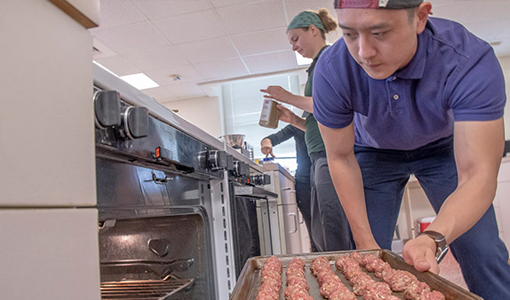
 Lizzy Mueller, a nutrition and dietetics major, experiments for the first time with pasta dough made from corn flour and potato starch.
Lizzy Mueller, a nutrition and dietetics major, experiments for the first time with pasta dough made from corn flour and potato starch.
It’s tucked away, unassuming, on the third floor of the Stone Building. You wouldn’t know it’s there, but the smell of roasted garlic gives it away. Stone 303 is more than just a classroom – it’s an industrial-grade kitchen, and it’s home to NTR 403: Food Science and Technology.
Twice a week, the kitchen turns into a food chemistry lab, where students experiment with varied ingredients and their effects on taste and texture: marshmallows and gelling agents, eggless pumpkin pie, high-protein pasta and red velvet beet cake.
 Professor Ross jumps in to help senior Andrew Jones with a meatball mixture using 93 percent lean meat. Jones, a nutrition and dietetics major, said the class has pushed the boundaries of his cooking skills.
Professor Ross jumps in to help senior Andrew Jones with a meatball mixture using 93 percent lean meat. Jones, a nutrition and dietetics major, said the class has pushed the boundaries of his cooking skills.The course is required for nutrition students concentrating in wellness or human nutrition/dietetics. Alumna B. Burgin Ross ’08 MS is assistant professor in the Department of Nutrition and has been teaching the class since 2010.
“What I love about this class is she wants us to feel empowered in the kitchen and not intimidated,” student Lizzy Mueller said of Ross.
As she spoke, the senior nutrition and dietetics major rolled out pasta dough made from corn flour and potato starch.
Mueller plans to continue onto graduate school at UNC Greensboro and one day work in the nutrition field, helping clients with food allergies to make modifications and cook healthfully.
This semester, Ross has 16 students split between two labs, which meet each week for about two hours. The kitchen is stocked with everything students need: a closet full of pots and pans, ovens, mixers, food processors, a wall lined with spices and obscure ingredients – even a washer and dryer.

Students study shrinkage levels of various meat mixtures in meatballs.
“Since these students will be coming out of school needing the skill set to teach clients how to make healthier substitutions when cooking, this class allows them a place to try and practice such changes, in an environment where they can see and even taste what those changes do to products,” Ross said.
So what happens to the food the class prepares each week? Ross chuckled.
“It’s consumed!”
Originally published April 12, 2018. Story by Elizabeth L. Harrison. Photography by Martin W. Kane.